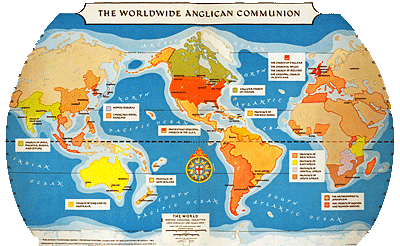A study published in the Journal of Anglican Studies says that the Anglican Communion is probably smaller that we think. The usual number is that there are 80 million Anglicans in the 38 provinces around the world, and that the Global South churches are booming while the North American and the United Kingdom are shrinking.
According to Daniel Muñoz, Lecturer in Church History, Protestant Faculty of Theology SEUT, Madrid, Spain, and as reported by Ruth Gledhill in Christian Today, there may be few active Anglicans in the Global South and more than we believed in the West:
Regarding Nigeria, often cited as a fast-growing province claiming 18 million members, he reports there could in fact be fewer than two million active Anglicans. In England, which lays claim 26 million supposed Anglicans among the 80 million figure, there are in fact about 1.7 million active Anglicans, he says. Australia claims nearly five million Anglicans but in fact just one tenth of these are active.
His analysis shows that of the nearly 80 million people claimed to be Anglican, the actual number of active Anglicans worldwide could be below nine million.
Muñoz attempts to deal with four separate problem is his research:
- Each province counts membership differently: some use baptized members; some adult confirmed communicants; others use other measures.
- There are differing definitions of what counts as an active member within that larger base.
- Four provinces are “united” churches, that is they are share members from other traditions under the one umbrella, so the possibility of double or even triple counting increases in those places.
- The unquestioned narrative that churches in the Global South are growing while those in the north are shrinking means that we don’t look closely at what is really going on.
Muñoz cites a decline or at least a plateau of growth in Kenya, Uganda, and Nigeria:
For every narrative, however, there is a counter-narrative. The counter-narrative I propose here is based on doctoral research into contemporary Anglican identity. This counter-narrative accepts the overall story, but it qualifies it. It says that whilst it is true that most of the growth of recent decades has taken place in parts of Africa and Asia, there is anecdotal evidence that this growth has reached a plateau and in some cases has turned into decline, in certain parts of Africa.
On the other hand, there are signs that the oft-cited decline in the West has slowed or even leveled off.
The other part of this narrative comes from the West. While it is true that Anglican churches in Western nations have experienced a steady decline during the second half of the twentieth century, there are signs that this trend may have changed in the first decade of the twenty-first century. Decline has slowed significantly and in some cases, like England, it has reached a plateau in the last decade.
Gledhill cites a Church of England spokesman who challenges Muñoz in his differentiation between baptized members and active membership. It is active membership that Muñoz emphasized in his study, saying that there probably only about 9 million “active” members of the Anglican communion worldwide.
An Anglican Communion spokesman said: “Although the Church of England has a professional statistics unit and can provide numbers and the basis on which they are calculated, other provinces in the Anglican Communion may use less sophisticated methods to estimate membership. We have not checked with them recently. However and more importantly, it is for Daniel Munoz to provide a theologically sound definition of church membership and the justification for dismissing baptism as the traditional gauge, if that is what he is doing.”
Statistics matter. It’s often said that organizations do what they measure. And batting around statistics is one way we tell our story. It has become a habit to use our numbers as weapons to back up our theological stands. But if it is true that the Churches in the Global South are experiencing stagnation in the rural areas, and even decline as these areas de-populate, and if the level of attendance in urban areas is also spotty or shrinking then perhaps, despite all the posturing, we have more in common than we’ve been willing to admit.
Maybe one of the implications for mission is that urbanization, migration, and technology are having impacts across the globe–and that all of us, Western and Global South churches are in the same boat. One lesson from a realistic view of how big and how active we are as Anglicans is that how we communicate the Gospel in this kind of world is the one really important issue that we all share.

